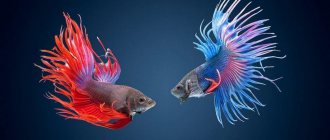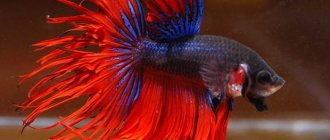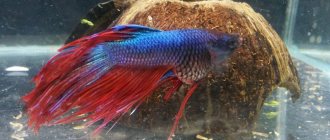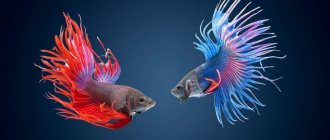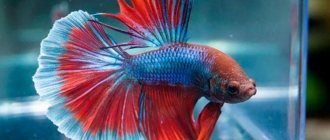Many people know the myth that tells that one of the Greek goddesses was born from sea foam. This story is fiction and will forever remain a legend. However, in fact, there are living creatures that are born in foam, albeit from fresh water. We are talking about labyrinth fish. These include Siamese fighting dogs. The breeding of betta fish is accompanied by a significant number of rituals and looks like a well-staged show. This process is unlikely to leave anyone indifferent.
general description
Breeding bettas in an aquarium is a fascinating sight. It often happens that no special efforts have to be made: the desired microclimate, temperature and chemical composition of the water are created in the home pond. However, it is worth taking a very responsible approach to the issue, providing optimal conditions for the fish.
If we talk about general requirements, then the following should be specially noted: a sufficient temperature of about 27 degrees, ph in the range from 6.7 to 7.3, so water that is too hard and old is not suitable.
Breeding cockerels at home can be divided into several separate stages that require serious thought and preparation:
- pair selection;
- preparation for spawning;
- spawning itself;
- rearing and development of fry.
Content Features
There is nothing difficult about keeping cockerels. Even novice aquarium enthusiasts can handle this just fine. First of all, it should be noted that they do not require a very large volume of the home aquarium. But it’s better to provide them with space, otherwise these fish will be uncomfortable and may get sick. Due to the presence of a labyrinth organ, these fish partially use atmospheric air for breathing. Therefore, aeration of the aquarium is not required for them. The water temperature, comfortable for bettas, is approximately 25-26°C, pH – 6.5-7.3. The water should be changed weekly.
How often can cockerels spawn?
The intervals between spawning must be determined based on a large number of factors. It is important to use an individual approach in each individual case. Some females collect eggs slowly, others quickly. Some fish may not be able to get rid of eggs without outside help. Therefore, the question of how to find out when a female betta is ready to spawn is very difficult. Spawning is necessary only when the fish has a significant “belly”, which is clearly visible even before feeding begins.
The requirements for spawning on the part of the male are not so stringent. There are no exact rules in this matter. But there is no need to spawn more than once every two weeks. Otherwise, the male may become exhausted.
Subtleties of reproduction
How to choose a couple to get the desired offspring
When selecting fish for a pair, you need to pay attention not only to the age, gender, size and color of the fish, it is equally important to be able to assess the condition of the betta. Choosing healthy fish for breeding will allow you to enjoy the contemplation of their relationships, rather than disappointment.
Condition of the fish
When choosing betta fish, the following parameters are assessed:
- The color of the male should be bright. Pale tones indicate illness.
- Fins - only with smooth edges, not torn or broken off.
- The eyes should not be cloudy or bulging.
- The body of a healthy cockerel is smooth, glossy, without scratches, injuries, spots, growths, the abdomen is round and dense.
- An active fish is most likely healthy. You can check this by placing your hand on the wall of the aquarium. If the cockerel reacted with a “fighting stance” and did not tremble or press its fins to its body, then you can safely take it into your aquarium.
Maintenance of breeders before spawning
After the separated couple has spent about two weeks in different aquariums, where each of the bettas fed heavily on live food, the male can be released into the spawning area. As soon as the color of the future parent becomes as bright as possible, and he himself begins to create a nest, a female can be placed with him. At that time, the female should already have a tightly packed abdomen with stripes on the sides, as well as an enlarged ovipositor (“egg” on the abdomen).
The cockerel may become distracted by the female and stop building the nest. In this case, you need to divide the aquarium into two parts with a transparent partition, and after 1 - 2 days it can be removed. If manufacturers are in no hurry to fulfill their functions, it is necessary to check the hardness and temperature of the water.
Matching
Before breeding these fish, it is important to decide on the goals being pursued and the desired result. The approach to breeding activities and simply the desire to get offspring is somewhat different. If we are talking specifically about selection, then identifying a pair is incredibly important . But if there is no such interest and two males of different sexes live in a common aquarium, then there are few options and the choice is obvious.
Sex differences in fish are quite clearly expressed; for the most part, there are no difficulties in determining sex. The female and male, whose differences from each other appear at the age of three months, must be the same size, and preferably the same color. Females have a white egg-like formation on their bellies; in addition, they have a more faded coloring and their fins are modest. Cavaliers amaze the imagination with the brightness of their coloring, beauty and length of tails.
It should be noted that the older the male, the more amazing his fins look. This is why it is extremely difficult to determine the sex of young individuals under 10-11 weeks of age. Betta fish that have grown up to 5-6 months, but not older than one and a half years, are suitable for reproduction. In more mature fighters, the ability to bear offspring noticeably decreases, various defects and injuries appear, and mortality among fry is high.
Sexual differences in aquarium bettas.
If you plan to specifically purchase female and male cockerels for spawning, then it is advisable to do this from professional breeders. Determining the age of a fish sold in a pet store can be quite difficult. In addition, if the individuals are too young, you can buy same-sex representatives and will have to purchase more.
Buying fish
This is an inexpensive and not scarce type of aquarium fish; they are sold in any pet store at a price of 150 rubles.
The only rule is that sudden changes in temperature are contraindicated, so if you decide to buy a cockerel, it is better to do it in the summer, or come to the store in a warm car. Many people practice taking a thermos with them, and transporting fish in it is a great idea, it works. Don’t forget about the rule for fry – buy them together with other fish if you decide to stock them with several species.
Preparing the spawning tank
For breeding bettas, an aquarium with a volume of 20-40 liters, filled with water to a height of 10-15 cm, is suitable. The aquarium must be equipped with a heater, lighting, and a filter. The water should be settled for 3-4 days, with a pH of 6.7-7.3. Hard old water will not work.
At the bottom of the tank for spawning bettas you need to fix a couple of holly plants. Place small floating algae on the surface of the water, in small quantities - riccia, duckweed, watercolor. They will be additional building material for the nest.
You can make a spawning tank for a betta yourself, for example, like in this photo. Here the female was placed in an aquarium with the male in a separate container.
Do not place pebbles or sand at the bottom of the aquarium; fallen eggs can easily get lost in the soil. Equip a grotto or other shelter for the female.
The optimal temperature for the start of spawning is 26-28˚C. The lighting should be dim and the filter turned off. The aquarium is located in a quiet place where no one will disturb the fish.
Simultaneously with preparing the breeding site, you need to take care of food for the fry in the first days of life. A three-liter jar is filled 2/3 with water, placing a piece of banana peel on the bottom. Add a teaspoon of milk. Place the jar in a warm place. After 3-4 days, you can notice the first ciliates that appear. In the summer, ciliates are grown in a garden barrel, putting hay dust in the water.
How we see ciliates with the naked eye and under a microscope.
The pet store buys a culture of microworms, which will be needed a little later. When the baby cockerels grow up noticeably.
Spawning
The male is first introduced into the breeding aquarium. He begins to build a nest from air bubbles, holding them together with saliva and parts of floating plants. The result is a cap of foam that rises above the water. The bright coloring of the partner and the completion of construction are signals that the time has come for the placement of a pregnant female.
The cockerel chases the female, delivering sensitive blows. At some point, the cockerel wraps itself around its partner, squeezes the eggs out of its abdomen and pours milk on it. The male picks up the fertilized eggs and carries them to the nest. The mating process is repeated 1-4 times. A sign of the end of reproduction: the male is busy with the nest, the female is hiding in a shelter. The female fish needs to be removed at this time.
If the males do not start breeding, they take measures: raise the temperature to +30˚C, soften the water using peat additives from the pet store, change some of the water. During one spawning, the female lays more than 600 whitish eggs of irregular shape.
The male wraps himself around the female and helps her push out the eggs.
Cockerels are not fed during breeding so as not to spoil the quality of water in the spawning area. This does not have any negative consequences for adult fish.
What care do fry need?
You should constantly ensure that the fry have food. You should start feeding small fish with ciliates
. This food is bred in advance, before spawning begins. To get ciliates, take a two-liter jar of water, add a teaspoon of milk and a small piece of dried banana peel. At first the water will darken, but after a couple of days it will become lighter, and infusor “clouds” will appear there. It is recommended to collect such food using a hose in the light. After which they are placed in the aquarium with the fry.
If ciliates are not at hand, you can use dry food
.
Snails and boiled yolk
are also useful as additional nutrition . It is worth noting that fry may not eat non-living food due to the fact that it does not move. In addition, such feeding very quickly pollutes the water.
The fry must be provided with an air spray with extremely low pressure. This is necessary because the labyrinthine apparatus is poorly developed in children.
The frequency of water changes depends on the food that the small bettas eat. If the fry feed
dry food, you should change at least 80% of the water daily. If you constantly consume live food, there is no need to frequently change the water in the aquarium.
3-4 days after such feeding, the fry can be switched to artemia
. It is also grown independently and in advance. To do this, you need to visit a pet store and purchase brine shrimp eggs. Then you need to fill a two-liter bottle with water, add 1.5 tsp. salt and the same amount of brine shrimp eggs. For a day you need to turn on strong aeration, after which the empty shell will float to the top, and the brine shrimp will swarm at the bottom of the container. You will also need to remove this food using a hose.
If you direct a beam of light to one corner or closer to the surface, the brine shrimp will gather in the light. This may make it easier to catch.
It is advisable to install not one, but two containers with live food, one day apart. Then food for the fry will be constantly available. The fry need to be fed twice a day. It is recommended to rinse the brine shrimp through gauze before feeding so as not to introduce a portion of salt into the baby’s aquarium.
As soon as the fish switch to brine shrimp, you should slightly increase the water level in the aquarium. A week or two after changing the diet, the fry can be given microplankton, small worms
, and after a little more time -
cut tubifex
.
Kinds
It is quite difficult to figure out which cockerel to buy, since there are many varieties. For example, the following are especially popular:
The Dragon
The shape of the fins is secondary. Their main difference is their large body and hard scales, slightly reminiscent of chain mail;
elephant ear
Quite a curious and beautiful fish. Has large veil fins. Its distinctive feature is its large circumbranchial fins, which exactly resemble elephant ears. This is where the name came from;
Comb-tailed
Happens quite often. It has a large caudal fin, the rays of which are quite long and extend beyond the binding membrane. This gives the impression that the tail is shaped like a comb or fan;
Royal
As mentioned above, the cockerel is a representative of the macropod family. This is especially noticeable in the royal appearance. It is large in size and resembles a macropod rather than a cockerel. An adult grows up to 8 cm in length. Most often they have short fins with a crescent-shaped tail. Very rare are veil or crown-tailed fins;
Delta
Outwardly similar to its veiled-tailed “brothers”. The fin develops as it moves, forming the Latin letter “Delta”;
Superdelta
From the name you can tell that this is a subspecies of the delta, but it also has similar features to the crescent. The edge of their tail develops, expanding almost 180°;
Short-tailed (aka poster)
It has short fins on the back and tail. Their width usually exceeds their length;
Brush-tailed (spear-tailed)
Another species with short fins. However, his tail is unusual, resembling a brush or a tongue of flame;
Round-tailed
The name speaks for itself. A fish with rounded fins. The closest to the wild species;
Two-tailed
The fin slightly resembles the shape of goldfish tails. It splits at the base and looks as if the individual actually has two tails;
Crown-tailed
It is distinguished by a large caudal fin resembling a crown. In addition, this species, in turn, is divided into three more subspecies, and each has its own ray shape;
Rosetail
A very unusual fish. It is popular among professionals because it has a bright color, as well as a large, luxurious tail fin, the rays of which are intertwined;
Feathertail
Another variety of cockerels with an impressive tail. It has an original structure, because the rays branch out like a feather;
half sun
A breeding form crossed from a crescent moon and a crown tail;
Crescent
It has a luxurious tail that forms a semicircle. The remaining fins are also impressive. Available in two-tone color;
Possible problems
Fish are very sensitive to any environmental changes. In order for them to begin to mate successfully, you need to be attentive to details:
- It is important to monitor the water temperature. In preparation for spawning and during spawning, the water temperature should be +27...+28 degrees.
- Keep fish away from direct sunlight.
- Cover the aquarium with a lid. The cockerels jump well.
- Do not use bottled water to fill the aquarium.
- Do not feed the fry dry food.
- Do not place natural shells with sharp edges in the aquarium.
To breed cockerels at home, you should choose pairs with the same fin shape (veiled, crown-tailed, etc.). The dominant color of these fish is red. This should also be taken into account when crossing, so that the reproduction of betta aquarium fish occurs predictably.
WHAT AND HOW MANY TIMES A DAY SHOULD YOU FEED A SCALARIA IN THE AQUARIUM
BREEDING ANKALARIUS IN A COMMON AQUARIUM
COMPATIBILITY OF COCKERS WITH OTHER FISH IN THE AQUARIUM
DISEASES OF MACROPODS: CAUSES AND TREATMENT
Habitat in nature
Under natural conditions, betta fish are found mainly in Southeast Asia in calm fresh water bodies: streams, rivers, and sometimes in rice fields. It should be noted that in nature their coloring is not at all so luxurious, although in some cases they appear to be dressed in beautiful outfits in natural reservoirs. They often live in rather muddy water, which is why they have a greenish-gray color. However, with the help of selection, it was possible to develop varieties of red, blue, purple and other bright colors, as well as with different shapes of fins and with a tail in the form of a crescent, crown, tassel, double, etc. Males are more brightly colored.
